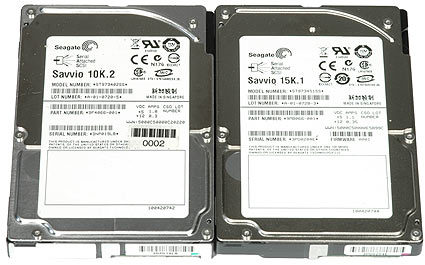SAS Hard Drives: 15,000 vs. 10,000 RPM
2.5" Kills 3.5"
The transition from 3.5" to 2.5" drives is under way in both the notebook and server segments. In addition to reduced weight and power consumption - which makes 1.8"- drives very interesting for media players and sub-notebooks - smaller hard drives offer servers other benefits.
On the one hand, 2.5" hard drives have a much smaller platter diameter and thus there is a smaller mass that must be moved while friction is reduced as well. On the other hand, the operating range of the slider (which carries the heads) is smaller, which has a positive impact on access time if you compare 3.5" and 2.5" at equal rotation speeds and mechanical components. A 2.5" server hard drive delivers somewhat slower transfer rates than 3.5" drives do, but they beat them in access time.
A 2.5" SAS drive currently reaches capacities of 147 GB at 10,000 RPM rotation speeds, or 73 GB if you want a 15,000-RPM drive. At the same time, 3.5" SAS and SCSI hard drives have been available in capacities of 300 GB for a while. If you come across other "enterprise-class" 3.5" drives you can be sure that these have their origin in the desktop space, but pass different validation and qualification processes to ensure the requirements of 24/7 operation are met. These drives only come with a SATA interface, but none of them supports SAS.
However, 2.5" SAS drives boost so-called storage density, because their required space is much lower when compared to 3.5" drives. This definition of storage density refers to storage capacity per volume, but it is also possible to define storage density as storage performance per volume. Popular storage appliances with only a single height unit (1U) either accept four 3.5" hard drives or as many as 10 2.5" drives - a good example is the Infostation by StorCase. Up to 10 do not require substantially more energy than four 3.5" drives, but they will outperform the four 3.5" drives by two times or sometimes even 2.5 times. If you decide to use 4-6 2.5" drives, you will receive at least equivalent performance at clearly reduced power consumption.
Get Tom's Hardware's best news and in-depth reviews, straight to your inbox.
Current page: 2.5" Kills 3.5"
Prev Page What's The Benefit Of 15,000 RPM? Next Page Seagate Savvio 10k.2: 10,000 RPM
Patrick Schmid was the editor-in-chief for Tom's Hardware from 2005 to 2006. He wrote numerous articles on a wide range of hardware topics, including storage, CPUs, and system builds.
-
DeanRS The Raid 0 benchmarks include Raid 5 File server that is also shown again in the Raid 5 Benchmarks section. Raid 5 shows webserver data and Raid 0 does not. I think that the Raid 0 webserver data is not shown as Raid 5 fileserver data is in its place.Reply
